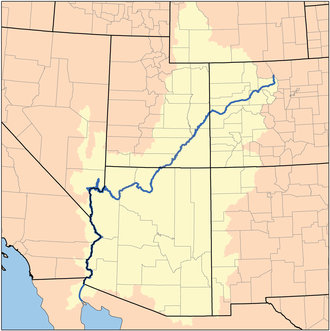Seven states are trying to broker a deal on how to divide up the dwindling waters of the Colorado River. However, different factions of squabbling states have their own visions on how to make the plan work – and no one wants to pull the short straw.
The Colorado River Basin covers around 673,396 square kilometers (260,000 square miles), around 8 percent of the mainland US, and serves as a critical water resource for 40 million people living across Arizona, California, Colorado, Nevada, New Mexico, Utah, and Wyoming.
Disputes over the river’s water rights have been lurking for over a century. In an early attempt to iron out their problem, the Colorado River Compact was signed in 1922 to regulate water distribution among seven states.
It did this by dividing them into two groups: the Upper Divisions states of Colorado, New Mexico, Utah, and Wyoming; and those of the Lower Divisions, California, Arizona, and Nevada. On top of this, there are tribal water rights to consider too.
Cracks have started to show in the centuries-old framework, however. Across our warming planet, once-stable water reserves are becoming increasingly strained. Two of Colorado’s largest reservoirs – Lake Powell and Lake Mead – have been hit particularly harshly, with water levels reaching shockingly low levels in recent years.
The shrinking water supplies can also be seen in the flow of the Colorado River, which has already declined by around 20 percent over the past century.

A map of the western USA showing the Colorado River in blue and its river basin in light yellow.
In May 2023, the water-stricken states reached a deal in which Arizona, California, and Nevada agreed to reduce intake by 3.7 billion cubic meters (3 million acre-feet) until the end of 2026.
Now comes the challenge of forming a long-term plan that everyone can agree on. During the first week of March 2024, the Upper Basin States and the Lower Basin States both submitted their competing plans for the post-2026 scenario.
Both schemes aim for the seven states to make water cuts, but the devil is in the details and both proposals have conflicting points that are both subtle and complex. There is no apparent agreement on which states should take the brunt of the cuts, plus there are disagreements on how to measure the available supplies of water. The Upper states want real-time live information to manage the flow of water “instead of unreliable forecasts”, but the Lower states believe this is a way of worming out of solid obligations.
“That proposal basically puts the entire burden of protecting the river system on the Lower Basin. They take no reductions under any circumstances,” Tom Buschatzke, director of the Arizona Department of Water Resources, said at a press conference, according to the Hill.
“Our proposal would result in reductions that are going to be certain. We need to see that out of the Upper Basin – not just policies and programs that might create some reductions,” Buschatzke argued.
The path toward agreement is currently unclear, but one thing is certain – something’s got to change.
“We can no longer accept the status quo of Colorado River operations,” Becky Mitchell, Colorado’s Commissioner to the Upper Colorado River Commission, said in a statement.
“If we want to protect the system and ensure certainty for the 40 million people who rely on this water source, then we need to address the existing imbalance between supply and demand.
“That means using the best available science to work within reality and the actual conditions of Lake Powell and Lake Mead. We must plan for the river we have – not the river we dream for,” explained Mitchell.
Source Link: Western US States Clash Over The Fate Of Colorado River